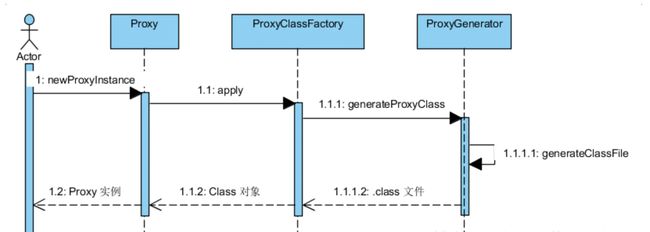【Java知识点详解 2】动态代理
一、代理模式
代理模式的定义:为其他对象提供一种代理以控制对这个对象的访问。在某些情况下,一个对象不适合或者不能直接引用另一个对象,而代理对象可以在客户端和目标对象之间起到中介的作用。
著名的代理模式例子为引用计数(英语:reference counting)指针对象。
当一个复杂对象的多份副本须存在时,代理模式可以结合享元模式以减少存储器用量。典型作法是创建一个复杂对象及多个代理者,每个代理者会引用到原本的复杂对象。而作用在代理者的运算会转送到原本对象。一旦所有的代理者都不存在时,复杂对象会被移除。
二、组成
抽象角色:通过接口或抽象类声明真实角色实现的业务方法。
代理角色:实现抽象角色,是真实角色的代理,通过真实角色的业务逻辑方法来实现抽象方法,并可以附加自己的操作。
真实角色:实现抽象角色,定义真实角色所要实现的业务逻辑,供代理角色调用。
三、优点
1、职责清晰
真实的角色就是实现实际的业务逻辑,不用关心其他非本职责的事务,通过后期的代理完成一件完成事务,附带的结果就是编程简洁清晰。
2、保护对象
代理对象可以在客户端和目标对象之间起到中介的作用,这样起到了中介的作用和保护了目标对象的作用。
3、高扩展性
四、模式结构
一个是真正的你要访问的对象(目标类),一个是代理对象,真正对象与代理
对象实现同一个接口,先访问代理类再访问真正要访问的对象。
代理模式分为静态代理、动态代理。
静态代理是由程序员创建或工具生成代理类的源码,再编译代理类。所谓静态也就是在程序运行前就已经存在代理类的字节码文件,代理类和委托类的关系在运行前就确定了。
动态代理是在实现阶段不用关心代理类,而在运行阶段才指定哪一个对象。
五、静态代理
创建一个接口,然后创建被代理的类实现该接口并且实现该接口中的抽象方法。之后再创建一个代理类,同时使其也实现这个接口。在代理类中持有一个被代理对象的引用,而后在代理类方法中调用该对象的方法。
使用静态代理很容易就完成了对一个类的代理操作。但是静态代理的缺点也暴露了出来:由于代理只能为一个类服务,如果需要代理的类很多,那么就需要编写大量的代理类,比较繁琐。
六、动态代理
1、动态代理流程图
2、动态代理代码实现
(1)代理类
利用反射机制在运行时创建代理类。
接口、被代理类不变,我们构建一个ProxyInvocationHandler类来实现InvocationHandler接口。
package com.guor.aop.dynamicproxy;
import java.lang.reflect.InvocationHandler;
import java.lang.reflect.Method;
import java.lang.reflect.Proxy;
public class ProxyInvocationHandler implements InvocationHandler {
private Object target;
public Object getTarget() {
return target;
}
public void setTarget(Object target) {
this.target = target;
}
//生成得到代理类
public Object getProxy() {
return Proxy.newProxyInstance(this.getClass().getClassLoader(), target.getClass().getInterfaces(),this);
}
//处理代理实例,并返回结果
public Object invoke(Object proxy, Method method, Object[] args) throws Throwable {
log(method.getName());
//动态代理的本质就是使用反射机制来实现
Object result = method.invoke(target, args);
return result;
}
public void log(String msg) {
System.out.println("执行了"+msg+"方法");
}
}通过Proxy类的静态方法newProxyInstance返回一个接口的代理实例。针对不同的代理类,传入相应的代理程序控制器InvocationHandler。
(2)被代理类UserService
package com.guor.aop;
public interface UserService {
public void add();
public void delete();
public void update();
public void query();
}package com.guor.aop;
public class UserServiceImpl implements UserService {
public void add() {
System.out.println("add");
}
public void delete() {
System.out.println("delete");
}
public void update() {
System.out.println("update");
}
public void query() {
System.out.println("query");
}
}(3)执行动态代理
package com.guor.aop.dynamicproxy;
import com.guor.aop.UserService;
import com.guor.aop.UserServiceImpl;
public class Client {
public static void main(String[] args) {
//真实角色
UserService userService = new UserServiceImpl();
//代理角色
ProxyInvocationHandler pih = new ProxyInvocationHandler();
//通过调用程序处理角色来处理我们要调用的接口对象
pih.setTarget(userService);
UserService proxy = (UserService) pih.getProxy();
proxy.update();
}
}(4)控制台输出
七、动态代理底层实现
1、动态代理具体步骤
- 通过实现 InvocationHandler 接口创建自己的调用处理器;
- 通过为 Proxy 类指定 ClassLoader 对象和一组 interface 来创建动态代理类;
- 通过反射机制获得动态代理类的构造函数,其唯一参数类型是调用处理器接口类型;
- 通过构造函数创建动态代理类实例,构造时调用处理器对象作为参数被传入。
2、源码分析
(1)newProxyInstance
既然生成代理对象是用的Proxy类的静态方newProxyInstance,那么我们就去它的源码里看一下它到底都做了些什么?
@CallerSensitive
public static Object newProxyInstance(ClassLoader loader,
Class[] interfaces,
InvocationHandler h)
throws IllegalArgumentException
{
Objects.requireNonNull(h);
final Class[] intfs = interfaces.clone();
final SecurityManager sm = System.getSecurityManager();
if (sm != null) {
checkProxyAccess(Reflection.getCallerClass(), loader, intfs);
}
/*
* Look up or generate the designated proxy class.
*/
Class cl = getProxyClass0(loader, intfs);
/*
* Invoke its constructor with the designated invocation handler.
*/
try {
if (sm != null) {
checkNewProxyPermission(Reflection.getCallerClass(), cl);
}
final Constructor cons = cl.getConstructor(constructorParams);
final InvocationHandler ih = h;
if (!Modifier.isPublic(cl.getModifiers())) {
AccessController.doPrivileged(new PrivilegedAction() {
public Void run() {
cons.setAccessible(true);
return null;
}
});
}
return cons.newInstance(new Object[]{h});
} catch (IllegalAccessException|InstantiationException e) {
throw new InternalError(e.toString(), e);
} catch (InvocationTargetException e) {
Throwable t = e.getCause();
if (t instanceof RuntimeException) {
throw (RuntimeException) t;
} else {
throw new InternalError(t.toString(), t);
}
} catch (NoSuchMethodException e) {
throw new InternalError(e.toString(), e);
}
} (2)getProxyClass0
利用getProxyClass0(loader, intfs)生成代理类Proxy的Class对象。
private static Class getProxyClass0(ClassLoader loader,Class... interfaces) {
if (interfaces.length > 65535) {
throw new IllegalArgumentException("interface limit exceeded");
}
// If the proxy class defined by the given loader implementing
// the given interfaces exists, this will simply return the cached copy;
// otherwise, it will create the proxy class via the ProxyClassFactory
return proxyClassCache.get(loader, interfaces);
}(3)ProxyClassFactory
ProxyClassFactory内部类创建、定义代理类,返回给定ClassLoader 和interfaces的代理类。
private static final class ProxyClassFactory implements BiFunction[], Class>
{
// prefix for all proxy class names
private static final String proxyClassNamePrefix = "$Proxy";
// next number to use for generation of unique proxy class names
private static final AtomicLong nextUniqueNumber = new AtomicLong();
@Override
public Class apply(ClassLoader loader, Class[] interfaces) {
Map, Boolean> interfaceSet = new IdentityHashMap<>(interfaces.length);
for (Class intf : interfaces) {
/*
* Verify that the class loader resolves the name of this
* interface to the same Class object.
*/
Class interfaceClass = null;
try {
interfaceClass = Class.forName(intf.getName(), false, loader);
} catch (ClassNotFoundException e) {
}
if (interfaceClass != intf) {
throw new IllegalArgumentException(
intf + " is not visible from class loader");
}
/*
* Verify that the Class object actually represents an
* interface.
*/
if (!interfaceClass.isInterface()) {
throw new IllegalArgumentException(
interfaceClass.getName() + " is not an interface");
}
/*
* Verify that this interface is not a duplicate.
*/
if (interfaceSet.put(interfaceClass, Boolean.TRUE) != null) {
throw new IllegalArgumentException(
"repeated interface: " + interfaceClass.getName());
}
}
String proxyPkg = null; // package to define proxy class in
int accessFlags = Modifier.PUBLIC | Modifier.FINAL;
/*
* Record the package of a non-public proxy interface so that the
* proxy class will be defined in the same package. Verify that
* all non-public proxy interfaces are in the same package.
*/
for (Class intf : interfaces) {
int flags = intf.getModifiers();
if (!Modifier.isPublic(flags)) {
accessFlags = Modifier.FINAL;
String name = intf.getName();
int n = name.lastIndexOf('.');
String pkg = ((n == -1) ? "" : name.substring(0, n + 1));
if (proxyPkg == null) {
proxyPkg = pkg;
} else if (!pkg.equals(proxyPkg)) {
throw new IllegalArgumentException(
"non-public interfaces from different packages");
}
}
}
if (proxyPkg == null) {
// if no non-public proxy interfaces, use com.sun.proxy package
proxyPkg = ReflectUtil.PROXY_PACKAGE + ".";
}
/*
* Choose a name for the proxy class to generate.
*/
long num = nextUniqueNumber.getAndIncrement();
String proxyName = proxyPkg + proxyClassNamePrefix + num;
/*
* Generate the specified proxy class.
*/
byte[] proxyClassFile = ProxyGenerator.generateProxyClass(
proxyName, interfaces, accessFlags);
try {
return defineClass0(loader, proxyName,
proxyClassFile, 0, proxyClassFile.length);
} catch (ClassFormatError e) {
/*
* A ClassFormatError here means that (barring bugs in the
* proxy class generation code) there was some other
* invalid aspect of the arguments supplied to the proxy
* class creation (such as virtual machine limitations
* exceeded).
*/
throw new IllegalArgumentException(e.toString());
}
}
} (4)generateProxyClass
一系列检查后,调用ProxyGenerator.generateProxyClass来生成字节码文件。
public static byte[] generateProxyClass(final String name,Class[] interfaces,int accessFlags)
{
ProxyGenerator gen = new ProxyGenerator(name, interfaces, accessFlags);
final byte[] classFile = gen.generateClassFile();
if (saveGeneratedFiles) {
java.security.AccessController.doPrivileged(
new java.security.PrivilegedAction() {
public Void run() {
try {
int i = name.lastIndexOf('.');
Path path;
if (i > 0) {
Path dir = Paths.get(name.substring(0, i).replace('.', File.separatorChar));
Files.createDirectories(dir);
path = dir.resolve(name.substring(i+1, name.length()) + ".class");
} else {
path = Paths.get(name + ".class");
}
Files.write(path, classFile);
return null;
} catch (IOException e) {
throw new InternalError(
"I/O exception saving generated file: " + e);
}
}
});
}
return classFile;
} (5)generateClassFile
生成代理类字节码文件的generateClassFile方法:
private byte[] generateClassFile() {
/* ============================================================
* Step 1: Assemble ProxyMethod objects for all methods to
* generate proxy dispatching code for.
*/
/*
* Record that proxy methods are needed for the hashCode, equals,
* and toString methods of java.lang.Object. This is done before
* the methods from the proxy interfaces so that the methods from
* java.lang.Object take precedence over duplicate methods in the
* proxy interfaces.
*/
addProxyMethod(hashCodeMethod, Object.class);
addProxyMethod(equalsMethod, Object.class);
addProxyMethod(toStringMethod, Object.class);
/*
* Now record all of the methods from the proxy interfaces, giving
* earlier interfaces precedence over later ones with duplicate
* methods.
*/
for (Class intf : interfaces) {
for (Method m : intf.getMethods()) {
addProxyMethod(m, intf);
}
}
/*
* For each set of proxy methods with the same signature,
* verify that the methods' return types are compatible.
*/
for (List sigmethods : proxyMethods.values()) {
checkReturnTypes(sigmethods);
}
/* ============================================================
* Step 2: Assemble FieldInfo and MethodInfo structs for all of
* fields and methods in the class we are generating.
*/
try {
methods.add(generateConstructor());
for (List sigmethods : proxyMethods.values()) {
for (ProxyMethod pm : sigmethods) {
// add static field for method's Method object
fields.add(new FieldInfo(pm.methodFieldName,
"Ljava/lang/reflect/Method;",
ACC_PRIVATE | ACC_STATIC));
// generate code for proxy method and add it
methods.add(pm.generateMethod());
}
}
methods.add(generateStaticInitializer());
} catch (IOException e) {
throw new InternalError("unexpected I/O Exception", e);
}
if (methods.size() > 65535) {
throw new IllegalArgumentException("method limit exceeded");
}
if (fields.size() > 65535) {
throw new IllegalArgumentException("field limit exceeded");
}
/* ============================================================
* Step 3: Write the final class file.
*/
/*
* Make sure that constant pool indexes are reserved for the
* following items before starting to write the final class file.
*/
cp.getClass(dotToSlash(className));
cp.getClass(superclassName);
for (Class intf: interfaces) {
cp.getClass(dotToSlash(intf.getName()));
}
/*
* Disallow new constant pool additions beyond this point, since
* we are about to write the final constant pool table.
*/
cp.setReadOnly();
ByteArrayOutputStream bout = new ByteArrayOutputStream();
DataOutputStream dout = new DataOutputStream(bout);
try {
/*
* Write all the items of the "ClassFile" structure.
* See JVMS section 4.1.
*/
// u4 magic;
dout.writeInt(0xCAFEBABE);
// u2 minor_version;
dout.writeShort(CLASSFILE_MINOR_VERSION);
// u2 major_version;
dout.writeShort(CLASSFILE_MAJOR_VERSION);
cp.write(dout); // (write constant pool)
// u2 access_flags;
dout.writeShort(accessFlags);
// u2 this_class;
dout.writeShort(cp.getClass(dotToSlash(className)));
// u2 super_class;
dout.writeShort(cp.getClass(superclassName));
// u2 interfaces_count;
dout.writeShort(interfaces.length);
// u2 interfaces[interfaces_count];
for (Class intf : interfaces) {
dout.writeShort(cp.getClass(
dotToSlash(intf.getName())));
}
// u2 fields_count;
dout.writeShort(fields.size());
// field_info fields[fields_count];
for (FieldInfo f : fields) {
f.write(dout);
}
// u2 methods_count;
dout.writeShort(methods.size());
// method_info methods[methods_count];
for (MethodInfo m : methods) {
m.write(dout);
}
// u2 attributes_count;
dout.writeShort(0); // (no ClassFile attributes for proxy classes)
} catch (IOException e) {
throw new InternalError("unexpected I/O Exception", e);
}
return bout.toByteArray();
} 字节码生成后,调用defineClass0来解析字节码,生成了Proxy的Class对象。在了解完代理类动态生成过程后,生产的代理类是怎样的,谁来执行这个代理类。
其中,在ProxyGenerator.generateProxyClass函数中 saveGeneratedFiles定义如下,其指代是否保存生成的代理类class文件,默认false不保存。
在前面的示例中,我们修改了此系统变量:
System.getProperties().setProperty("sun.misc.ProxyGenerator.saveGeneratedFiles", "true");
上一篇:【全栈最全Java框架总结】SSH、SSM、Springboot
下一篇:Spring常用注解(绝对经典)



